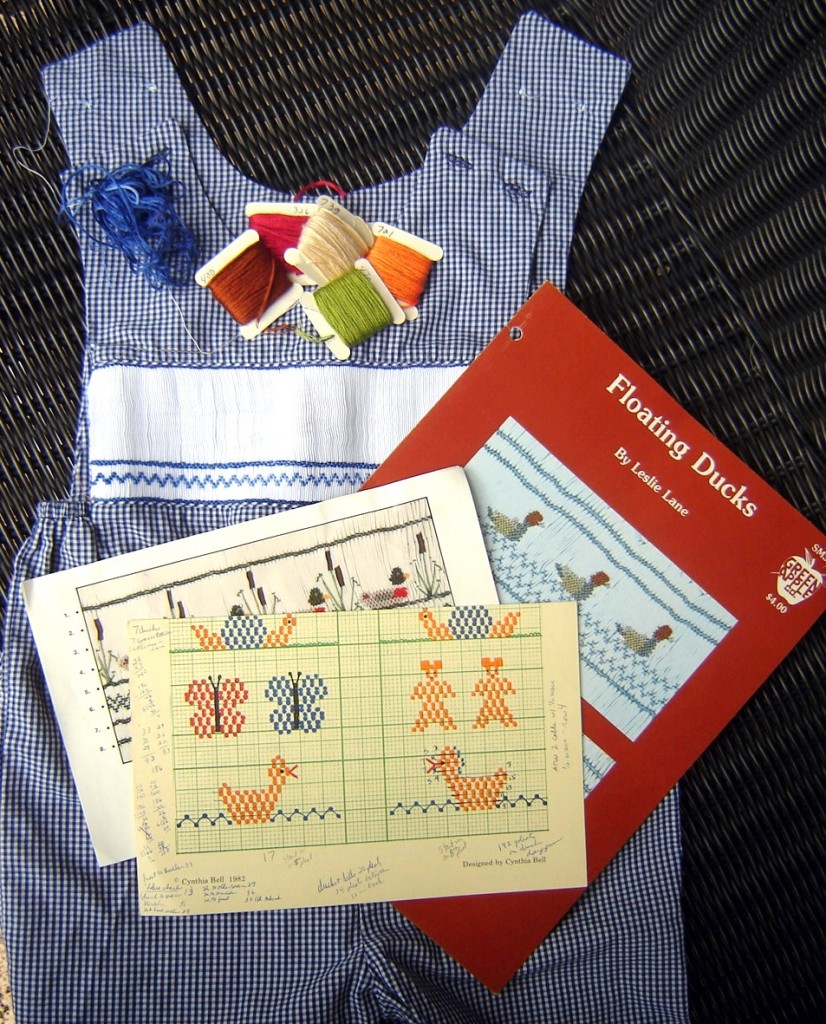These ready-to-smock garments are a real responsibility! All were purchased for Robert and Laurel who have outgrown the remainder of my stash. So now I am scurrying to finish up the boy’s things for 18 month-old Alastair.
His mother has requested some duck themed clothing, since his Alastair’s middle name is Drake. I wanted to go a little further and concentrate on the drakes. So I pulled out some old smocking plates and designs and plan to combine them for something a little less repetitive than either scene. The yellow graphs were someone’s good idea for miniature smocking but they never caught on. Still, I bought one of each and have used them periodically for tiny designs.
I especially like the cattails in Jerry Stock’s plate and the drakes in the leaflet, though I see now that the ones I like are obscured by the graph design. The scan on the right shows how dramatic they are. They should show up nicely on the white Jon-Jon insert.Â
This Jon-Jon suit is a work in progress, something I thought I would finish while “vacationing” in NC. Was I crazy?!#$??? With three children and outings and homeschooling, I didn’t do a stitch. So now I am trying to get this finished before grandson #2 outgrows it.
TECHNIQUE: I’ve learned some interesting things, already. But be forewarned–they will be of little interest unless you have a need to pursue the fine points of smocking, though they make little difference to anyone but the stitcher.  In an effort to make the water a little more realistic and interesting, I had planned to combine two colors of blue floss. This idea was drawn from a spectacular little daygown in Miss Dot’s Photo Gallery at one of my favorite sites,  Farmhouse Fabrics.  The fabric is white dotted Swiss, with green dots. Miss Dot smocked it white two strands of one green and a third strand in a lighter shade. Check out this photo gallery if you are in need of inspiration or just some eye candy.
After deliberating about the floss colors, I decided that I would just use variegated floss. This was far more challenging and less successful than the two-color combo method. First, each variegation is so long that you’d almost need a river to see any change in shade. Additionally, I chose to use 4 strands, which left 2 behind.
Normally, I would strip the floss, thread three strands through the needle and knot the same end of the remaining 3 strands. This was put aside. But by having only 2 strands–1/2 needed–I had to pull out another whole length of floss. Then, after stripping it and pulling out two strands, I realized that the variegation was not the same in each half. I let it go.
Now, it hardly matters. But I did not get the variation in color that I wanted.
The next thing I learned was that when tying off in the middle of a row, I’d best match the color of end of that strand with the beginning of the next. But then the grain of the floss is going the wrong way and my floss would wear out more quickly. So I had to make my way up the lengthy variations until I could match the ends.
Does this make sense to you? It’s really an easy thing to see when you are working with the variegated floss but a difficult thing to describe.
Suffice it to say, that the next time I decide I want some variation in the density of a color, I will use Miss Dot’s technique of mixing two solid colors of  floss rather than using variegated.
I’d better get to smocking or Alastair will have outgrown this before he gets a chance to wear it, just like his cousin Robert.





2 responses to “Drakes”